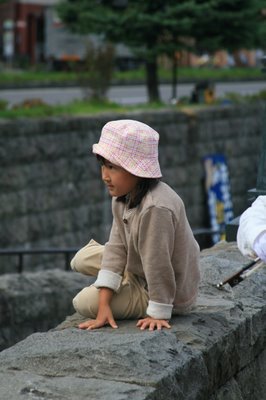 After two more sea days, we were anxious to get to Japan. This is our first time here and we’re looking forward to exploring. My sister taught English in Japan for a year or two after she graduated from Harvard in the early 1990s and she always raves about how beautiful the country is and how incredibly nice the people are. We were about to find out just how right my sister was!
After two more sea days, we were anxious to get to Japan. This is our first time here and we’re looking forward to exploring. My sister taught English in Japan for a year or two after she graduated from Harvard in the early 1990s and she always raves about how beautiful the country is and how incredibly nice the people are. We were about to find out just how right my sister was!We docked in a fairly industrial area of Otaru Canal (Otaru Unga) on the island of Hokkaido. With our binoculars we could see quite a bit of the city and the surrounding hillside. After spending a day here, we decided that it’s a lovely little town, even if there isn’t too much to do.
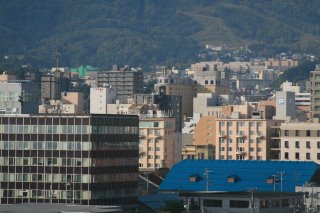
We started the morning with a tour of an indoor market with Quinn McMahon (executive chef of the Mariner) and the Le Cordon Bleu chef and teacher, Frank Jeandon. This was a terrific bonus offered to the participants of the Le Cordon Bleu cooking class and their spouses. Private taxis (watch those automatic doors!) took us from the dock to the market and waited while we were inside.
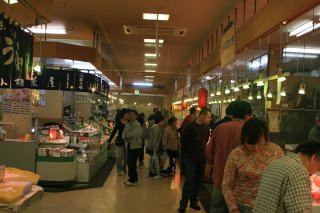 If you’re in Japan, you must visit one of these spectacular markets! We were amazed at the wide variety of foods and the just-caught freshness of all the seafood. You know the smell of an American fish market? It sometimes smells, well, fishy or fishy with a hint of bleach. That was not the case here. In fact, there was no scent at all other than the hint of sweetness from cut flowers and the bread in the bakery! So fresh!
If you’re in Japan, you must visit one of these spectacular markets! We were amazed at the wide variety of foods and the just-caught freshness of all the seafood. You know the smell of an American fish market? It sometimes smells, well, fishy or fishy with a hint of bleach. That was not the case here. In fact, there was no scent at all other than the hint of sweetness from cut flowers and the bread in the bakery! So fresh!
 Hokkaido is known for crab and you’ll definitely find it at this market! There were dozens of kiosks with row upon row of crab! It was a sight to behold! The market offered dozens of types of fish and shellfish, as well as fish eggs, seaweed, fresh fruit and vegetables, bakery items, sweets and other items I couldn’t identify.
Hokkaido is known for crab and you’ll definitely find it at this market! There were dozens of kiosks with row upon row of crab! It was a sight to behold! The market offered dozens of types of fish and shellfish, as well as fish eggs, seaweed, fresh fruit and vegetables, bakery items, sweets and other items I couldn’t identify.We purchased several sweet bean cakes, skewered meats and rice balls. Our group then stopped for lunch at the sushi counter. (I’m not much of a raw fish eater but my husband raved about the quality and freshness of the sweet shrimp, tuna, eel, scallops and other items we were served.)
 We then piled back into the taxi and asked the white-gloved driver to drop us off near the Sakai-machi Street Historic District so we could do our own thing for the rest of the day.
We then piled back into the taxi and asked the white-gloved driver to drop us off near the Sakai-machi Street Historic District so we could do our own thing for the rest of the day.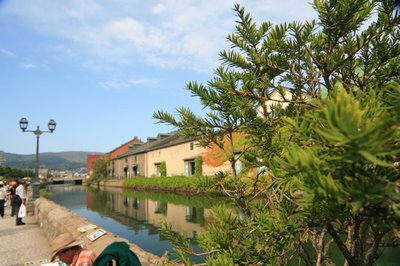
Once a busy port known for its herring trade, the highlight of Otaru is now its Meiji-era canal and brick warehouses which have been converted to gift shops and restaurants. This historic (i.e., tourist) area is outfitted with tree-lined cobblestone streets, brick buildings and old-fashion gas lamps. While we explored, we saw several strolling violinists and horse-drawn carriages were available to ferry tourists around town.
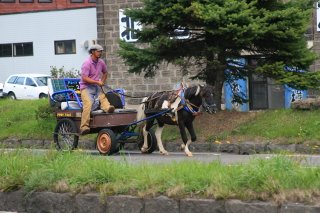
Unique gifts to be had in Otaru include music boxes (you’ll find several stores offering ready-made and customizable music boxes) and hand-blown glass items.
We spent our day eating, shopping and walking through the canal area. (Don’t miss the chocolates filled with melon wine sold throughout the city and the ale at the Otaru Brewery, both specialties of the area.)
Other highlights in the area include Goblin Hall, a small museum filled with tengu (long-nose goblin masks); Aoyama Villa with intricately painted sliding doors and lacquered floors; the Herring Mansion (Nishin Goten), the 1897 home of a fishery boss which now contains memorabilia of the herring boom time; and the Otaru Aquarium.
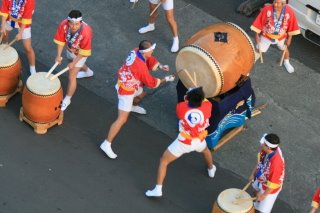 Regent offered several shore excursions in Otaru and also one to Sapporo, the capital of Hokkaido. That tour included quite a long bus ride so we were glad we decided to tour this port independently.
Regent offered several shore excursions in Otaru and also one to Sapporo, the capital of Hokkaido. That tour included quite a long bus ride so we were glad we decided to tour this port independently.Back on the Mariner, we were treated to an authentic tea ceremony in the Horizon Lounge and some local folklore entertainment from The Yosakoi Soran Team. This local troupe of children, teens and adults were dressed in traditional Japanese costumes.
Later as the Mariner prepared to leave Otaru, The Yosakoi Soran Team raced along the pier, waving, to bide us a fond farewell. What a fantastic day!
Photos by Leonard Hospidor
No comments:
Post a Comment